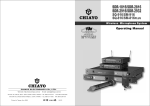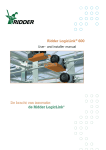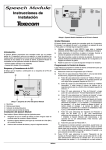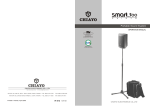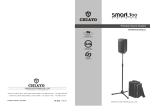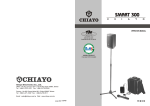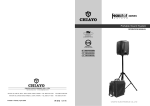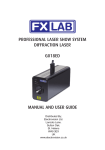Download Chiayo Challenger 1000 Operating instructions
Transcript
Caution and tips on how to obtain the best results. 1.Before inserting the batteries, please make sure that they are inserted according to the correct polarity. 2.For PLL 16 frequencies agile version, before operation please make sure that the corresponding receiver MUST have the same frequency group and channel number as the transmitter. 3.Before making any channel change,please switch off the power supply.The synthesized program works in such a way that a change of channel will only take place after a power off and on action. Otherwise, the previously selected frequency will stay unchanged. 4.After making a channel change, please make sure that the corresponding change is made on the matching receiver also. To be exact, changes MUST be made at both the transmitter and receiver. 5.The audio cable of VHF transmitters also serve as antenna. The length of the cable is cut according to the specific frequency range. Do not alter the length or mix around the cable of different transmitters. The use of wrong audio cable will affect the antenna efficiency of the transmitter! 6.Use only brand new Alkaline batteries. Do not use " general purpose " batteries.When batteries are weak, replace the all batteries at the same time. Do not mix and use new and old batteries together. 7.Position the receiver such that it has the least possible obstructions between it and the transmitter. Line of sight is bes ! 8.The transmitter and the receiver should be as close as possible but not less than 1m. 9..A receiver cannot receive signals from two or more transmitters simultaneously. 10.Turn the transmitter off when it is not in use. Remove the batteries if it is not to be used for a period of time. 11. Antennas form an integral part of the receiver and must be installed when in operation. Challenger 1000 / Challenger Slave Operation Manual Congratulation and thank you for purchasing this all-in-one state-of-the-art portable sound system. To ensure a trouble free operation, please go through this manual thoroughly to fully understand its controls and functions. The following table gives an overview of the various Challenger 1000 versions : VERSION UHF VHF U1DR U1TR U2DR U2TR V1DR V1TR V2DR V2TR Legend : U : UHF V : VHF D : CD T : TAPE NO. OF TAPE CHANNEL ( T ) CD (D) AC BATTERY AUDIO (R) LINK 1 1 2 2 1 1 2 2 Yes: No: R : Rechargeable Example : U2DR denotes UHF 2 channel with CD and Rechargeable battery. *Audio Link is standard in the Basic System. Note : Manufacturer reserves the rights to change the above combinations without prior notice. Remark : At present, the standard receiver module offered is the UHF 16 channel selectable version. In future, various versions of VHF / UHF model will also be offered as options. 20 1 CHALLENGER1000 (CD version configuration ) Installation of cable restraint To prevent contact noise caused by constant tension applied to the connector,,a cable restraint is designed such that tension is totally reduced when it is properly used. When the audio cable go through the cable restraint,it could prevent sweatfrom going diectly into the electronic board via the connector. This is another advantage of the cable restraint. 26 26 30 28 27 30 29 28 27 29 1 LCD Display Repeat Shuffle Play/Pause Stop disc F-skip/FF B-skip/Review Mode selector Eject COMPACT DISC PLAYER Installation of Lavalier / Headset microphones or instrument inputs Depending on customer requirements, Lavalier / Headset microphone or instrument inputs could be connected to the transmitter via the audio input connector. User is free to choose the various input sources but is advised to take note that connector used must be compatible to each other. The pin configurations of mini XLR connector are as follow ( Fig.1 ). mini XLR connector LED INDICATOR GT IN OFF 1 2 3 4 5 6 7 8 9 10 11 12 13 15 16 ON 2 3 4 1 POWER ANTENNA MT IN GND POWER SWITCH PHANTOM POWER Fig. 1 14 Input Level Gain Control Adjustment 20 17 Low impedance ( Lo-Z ) " MT" & high impedance ( Hi-Z ) " GT" gain controls are situated inside the transmitter as shown in Fig 10. Gain controls are adjustment ports that enable you to use microphones of differing output levels and Guitar or instruments with Hi-Z output. To adjust microphone ( Lo-Z ) input levels, turn the " MT" control and to adjust the Guitar or instrument ( Hi-Z ) input, adjust the " GT" gain control to set the transmitter's desired audio input level. 18 19 Fig. 1 2 19 CHALLENGER1000 (TAPE version configuration ) Installation of Belt-clip This specially designed detachable belt-clip allows the user to wear the transmitter with antenna pointing upward or downward as illustrated. To wear the transmitter with the transmitter pointing upward, install the belt-clip as in Fig.4. To wear the transmitter with the antenna pointing downward, please install the belt-clip as in Fig,5. Charging points 26 26 30 28 27 Fig. 4 30 29 29 28 27 Fig. 5 Eject key Counter Charging points Variable Speed control Auto reverse indicator Single reverse indicator Single side indicator Mode selector Fast forward Forward play Stop Reverse play Fast reverse Channel selection and gain adjust Channel selector and gain adjust are hidden in the designated cover in the front as shown in picture. To make channel selection and gain adjust, please press the designated cover and flip it open as shown. Channel selection can be made by rotating the selector with a small SM-916 screw driver. Gain adjust for Lavalier and Headset microphones can be done by adjusting the MT switch, whereas GT switch is for the gain adjust of electric Guitar MT and other high impedance line level Channel SM-816 inputs. Selector 1 2 3 5 4 Record 6 7 11 8 9 12 10 14 13 15 16 GT 20 17 CH SW 3 12 13 14 1 5 16 1 2 11 7 8 9 10 MT 19 4 5 6 GT 18 Channel selection Channel selection is possible only for SM-816 plus transmitters. To change channel, please open the battery cover and access the rotary switch to select channel with a small screw driver. 18 Fig. 2 3 CHALLENGER1000 (SLAVE configuration) Installation of batteries( SM-916) Installation of batteries( SM-816 PLUS) 21 22 23 Fig. 3 4 17 CHALLENGER1000 (Companion speaker) Belt-Pack Transmitter (SM-816PLUS/SM-916) Antenna Battery status Indicator Power switch SM-816PLUS Audio input Connector Cable restraint Battery Compartment Charging points Capsuale Mike clip Line Control Antenna Battery status Indicator Power switch Audio input Connector Cable restraint Battery Compartment SM-916 24 25 Capsuale Mike clip Line Control Fig. 4 16 5 Challenger 1000 Rear panel configuration ( Fig. 1 & Fig. 2 ) The rear panel is divided into three different sections as follow : A.Compartment for receiver modules B.CD player / Cassette Recorder C.Controls Sensitivity switch Receiver modules compartment At present, the standard receiver module offered is the 16 channel selectable UHF receiver module. PLL synthesized 16 channel receiver module(26) Power ON & Volume Control (30) Power ON indicator (29) Channel selector (27) Diversity A / B ( RF ) indicator (28) In future, different versions of VHF / UHF receiver module will also be available. TAPE / CD control Power ON switch and Volume control for Tape / CD player ( 3 ). Changing of capsule AUDIO LINK active out Active Out jack ( 8 ) to SLAVE unit. Maximum number of SLAVE units to be connected with a MASTER in daisy chain is about 20. LINE IN / LINE OUT Standard RCA jack for LINE IN / OUT ( 9 ). LINE IN volume control ( 4 ) TONE control Tone control for Bass / Treble adjust ( 5 ) for TAPE / CD. MASTER Volume Control ( 10 ) It controls the mixed output volume of the MASTER unit as well as all the following SLAVE units. Power Supply and Output controls This section is identical for both Challenger 1000 ( Master ) and the Challenger Slave. Main Power switch ( 17 ) Power Supply ( weak battery ) indicator RED ( 15 ). Power Supply ( good battery ) indicator GREEN ( 16 ). Voice Priority ( Ducking ) switch ( 18 ) ( not available for Challenger Slave ). 90 ~ 260 V AC IN jack ( 19 ) Charging indicator ( 20 ) Speaker out ( unswitched ) ( 12 ) Speaker out ( switched ) ( 11 ) 24V ~ 32 V DC IN jack ( 13 ) 5A Fuse holder ( 14 ) 6 Operating instructions 1.Before operation, please check and make sure that transmitter & receiver are of matching frequency or frequency group (for PLL version). For PLL version, further verify that the channel selected at both ends are of the same. 2.To switch on the microphone, put the switch to "ON" position. The green LED indicator will light on indicates that battery is fresh. When RED LED light on indicates that battery is weak, thus a replacement is necessary. 3.For best result, alkaline battery is recommended. Please remove the battery if the transmitter is not to be used for a longer period. 4.When necessary, mic capsule could be replaced by pulling out and plugging in the new one, either dynamic or condenser for SQ-916. 15 Challenger Slave Hand-held microphone The Challenger Slave is an active ( powered ) speaker unit with built-in switching power supply as well as rechargeable batteries, complete with similar charging circuit as that of the Challenger 1000 Master unit. It is an extended and indispensable member of the Challenger Audio Link system. Audio Link Active Bus controls 1 .A c t i v e b u s I N ( 2 1 ) 2 .A c t i v e b u s O U T ( 2 2 ) 3 .S l a v e v o l u m e c o n t r o l ( 2 3 ) Challenger Speaker ( C-SP ) The Challenger Speaker is a passive companion speaker for the Challenger 1000 series. It is for connection to the switched or unswitched speaker outs of the Challenger 1000 ( Master ) or the Challenger Slave units. Rear panel configuration. 1 .S p e a k e r I N ( 2 4 ) 2 .S p e a k e r O U T ( 2 5 ) Mechanical Parts Battery All the Challenger 1000 ( Master ), Challenger Slave and the Challenger companion speaker enclosures have the identical mechanical parts as follow : Three stages Trolley ( 31 ) Trolley release button ( 32 ) Wheels ( 33 ) Handle ( 34 ) Tripod mount bracket ( 35 ) ( not application for Challenger Slave and companion speaker ) 34 32 31 33 Pre ss 35 14 Remark : Please be advised that the trolley and wheels are meant for moving around on smooth surface and short distance only. It is NOT meant or built for heavy duty long distance transportation or on rough surfaces. Please DO NOT use the trolley as handle for going up and down the staircase. For going up and down the staircase, please use the Handle ( 34 ). 7 Operating procedures Simple DIY Trouble-shooting : After unpacking the unit for the first time, please charge the rechargeable batteries first for about 10 to 15 hours before any operation. The batteries were fully charged in the factory before shipment. However, the unit you have just unpacked could have been several months after the shipment and the rechargeable batteries might have been fully discharged naturally. To charge the batteries, just plug in the AC supply and charging will start automatically. In the charging process, charging indicator LED ( 20 ) will be RED. When GREEN LED appears on the charging indicator ( 20 ), batteries are fully charged and normal operation could now be started. To operate using the rechargeable batteries, switch on the main power supply switch ( 17 ). When batteries are charged, power supply GREEN indicator (16 ) will be lighted up. The main power supply DOES NOT switch on the built-in cassette recorder or the CD player module as well as the receiver modules. They have their own individual power on switch. To operate the cassette deck or CD player, please switch on the TAPE / CD switch ( 3 ). To operate the receiver module, please switch on the power on switch on each receiver module front panel ( 30 ). When the power supply RED indicator (15) is lighted up instead, it means the built-in batteries are weak. Please charge the batteries first before usage ( for the very first time or the unit has not been used for a long time ) or you could also operate it while charging. The AC power supply is designed such that it also provides the power for the system while charging the batteries. Operating the Wireless Microphone System. To use the 1st wireless system, first switch on the receiver power supply switch (30) on the receiver control panel. Make sure that master volume control are set to minimum level before turning the receiver unit on. After switching on the receiver, set the master volume control (10 ) to mid level. Switch on the corresponding matching transmitter or handheld microphone ( please refer to the operating instruction of the individual transmitter ). When RF signal is being received by the receiver, the receiver RF diversity signal indicator A or B (28 ) on the control panel will light up. Rotate the volume control knob (30) on receiver module clockwise to the desired levels. When voice is spoken into the microphone, amplified sound should be heard over the built-in speaker. When operating the wireless microphone, please ensure that the correct channel appear on both the transmitter and receiver. To use the 2nd wireless system, repeat the above procedure on the 2nd receiver module and the corresponding transmitter. Operating the Wired / Cable Microphone To use the first wired microphone, simply plug in the wired microphone into the MIC 1 XLR / Phone jack combo connector ( 6 ) on the control panel. This unique connector accepts both XLR and 1/4 " Phone Jack male connector. Set the Master volume control ( 10 ) to mid level, rotate the volume control ( 1 ) clockwise on MIC 1 to increase the volume. When voice is spoken into the wired microphone, amplified sound should be heard over the built-in speaker. To use the second wired microphone, simply plug in the wired microphone into the XLR / Phone jack combo connector ( 7 ) on MIC 2 and repeat the above procedure with MIC 2 volume control ( 2 ). No sound when one speaks to the wireless microphone Please verify the followings: 1.Main power switch of the system should be ON. When power on LED not lighted up, it means that the battery is either weak or not charged. Please plug in the AC cable to charge the battery. The rechargeable battery has a life span of about 2 years. If the batteries have reached their life expectancy, please change them to a fresh pair. 2.The power switch of the corresponding receiver module should be put to ON. This is in dicated by the lighted power LED. When two wireless mikes are used, both power switches of the receiver modules must be ON. 3.Wireless mike should be switched ON and verify that the battery is o.k. ( please refer to wireless microphone operating manual ). 4.Please verify that the frequency on the wireless microphone and the corresponding built-in wireless receiver module are exactly the same frequency group and channel. 5.Master volume control of the system should be turned on. No sound when Cassette / CD player is used. Main power switch should be ON. When no light appear, it means that the battery is weak. Please plug in the AC cable to charge the battery. Tape / CD volume control is turned on but Master volume control not on. Ducking ( Voice Priority ) does not work Please ensure that the Voice Priority switch is put to ON position to activate the ducking circuitry. Audio Link does not work Only one OUT cable is connected from the MASTER to the IN jack of the 1st SLAVE unit. The OUT of the 1st SLAVE goes to the IN of the next SLAVE and so on. No power supply 1.Battery is faulty 2.Battery is not charged. Installation of Receiver module To install the receiver module, first remove the blank panel covering the module compartment, position the module such that it fit exactly into the guide rail in the module compartment and push it to the end so that the gold finger connection plug firmly fit into the socket provided. To secure the receiver module to the Challenger rear panel, tighten the receiver panel with two screws. To remove the receiver module, first unscrew the two screws on the module front panel, pull up the trolley, follow instruction as shown in the picture and push out the module with a screw driver. 2 1 Both wired and wireless microphones could be used simultaneously as a built-in mixer mixes all the input signals. 8 13 Battery Charging Operating the CD player. Internally, the Challenger 1000 / Challenger Slave contain 2 pcs of 12V / 4.5AH maintenance-free lead acid rechargeable battery, which has no memory effect. When the battery is weak, the power indicator ( 15 ) RED LED will be lighted up when the main power switch is switched on. To charge the battery, simply plug in the AC power supply, the charging process will start automatically. While charging, the charging indicator ( 20 ) will be in RED. When battery is fully charged, the charging indicator ( 20 ) will stay GREEN. To begin operation, first switch on the TAPE / CD Power switch ( 3 ). Speaker out ( unswitched ) ( 12 ) PLAY / PAUSE SHUFFLE STOP When an external speaker is connected to this output, both the internal speaker of Challenger 1000 and the external speaker will have sound. REV-SKIP Speaker Out ( switched ) ( 11 ) When an external speaker is connected to this output, the internal speaker of Challenger 1000 will be muted and only the external speaker will have sound. Trolley release button ( 32 ) SKIP-FWD This button serves to release the locking mechanism of the trolley. To pull out the first stage of the handle, one does not need to press the button to release it. To pull the second and third stages of the handle, press the release button to unlock the mechanism. To put back the handle, press the release button to unlock the mechanism and return the handle to its original position. REPEAT/ENTER EJECT Specification Item Max. Power Output Distortion Frequency Response Input Speaker System Bass Speaker Tweeter Power Supply Charging Time Receiver Module Wired microphone Wireless microphone Output Dimension Weight Color Specification Max. 75W (RMS) / 4 Load < 0.5% 50HZ-20KHZ +/-3db Wireless receiver/ CD/ TAPE/ Wired Mic / Line In 3-Ways full range 10"8 100W/ 97db at 1W/ 1m AC 90-260V switching power 10-15 Hour UHF/ VHF band Chiayo or other compatible brand Handheld/ Lavalier/ Headset Speaker/ Speaker out(switched)/ Line out 400*350*300mm 18.5kg(TAPE) 17.5kg(CD) Black 12 PROGP When it is pressed during STOP, PLAY will start after track search. When it is pressed during PLAY, it will change to PAUSE mode. When it is pressed during PAUSE, it will change to PLAY mode. Press SHUFFLE to play the track randomly, the whole CD tracks will be played once. Press SHUFFLE again to clear the programming. When it is pressed at PLAY mode, CD will STOP. When CD is STOP, pressed this key once to decrease one track. When CD is in PLAY mode, press this key for < 1/2 second will make it search backward one track. When CD is in PLAY mode, press this key for >1/2 second will make it to execute FR Fast Reverse function. When CD is STOP, pressed this key once to increase one track. When CD is in PLAY mode, press this key for <1/2 second will make it search forward one track. When CD is in PLAY mode, press this key for >1/2 second will make it to perform the FF Fast Forward function. If this key is pressed in cyclical sequence, REPEAT mode will change as follow : "REPEAT" : repeat the same track. " REPEAT ALL" : repeat all tracks. When this key is pressed at either PLAY or STOP mode, door will move in and out cyclically. Programming procedures : Select the track by pressing B-SKIP / REW or F-SKIP / FF key to select the desired track and then press REPEAT/ENTER to store. This could be repeated to store a few programmed track. Press PLAY to perform the programmed tracks. Press PROGRAM again to clear the programming. Rotate the volume control knob ( 3 ) of the TAPE / CD control panel to adjust thevolume of the CD player. For Bass and Treble setting , adjust TONE control ( 5 ) . Clockwise from center line is to boost Treble and counter-clockwise direction from center line is to boost Bass. Caution: This CD player does not accept CD-R and 8cm diameter CD. Either one will cause malfunction to this CD player. 9 Operating the Cassette Recorder Audio Link Operation Schematic diagram To begin operation., first switch on the TAPE / CD Power On switch ( 3 ). Keys MASTER SLAVE SLAVE Audio Link Connection Plan SLAVE SLAVE FF Fast Forward FP Forward Play Stop RP Reverse Play FR Fast Reverse Record Mode selector SLAVE SLAVE The Challenger 1000 could be operated asMASTER only. The Challenger Slave can only be operated as SLAVE. In order to operate Audio Link, you must have a Challenger 1000 unitthat operates as a MASTER . Only one unit is allowed to act as MASTER and the other(s) MUST operate as SLAVE(s). A MASTER unit is capable of connecting up toabout 20 SLAVE units. For Active. To operate Audio Link, connect theActive Output ( 8 ) jack of the MASTER to the Audio Link IN ( 21 ) jack of the 1st SLAVE unit. The Out jack ( 22 ) of this SLAVE should be connected to the Input jack ( 21 ) of the 2nd SLAVE unit. Similar connection shall continue as such for the following SLAVE units. Volume Control ( 10 ) for MASTER or ( 23 ) for slave. When used on the MASTER, it controls the MASTER as wellas all the SLAVE units. When used on the SLAVE unit, it only controls that particular SLAVEunit volume. Maximum number of SLAVEunits to be connected with a MASTER is about 20. Speed Control Eject Functions Press this key for fast forward . Press this key for play in forward direction. Press this key to stop the tape. Press this key for play in reverse direction. Press this key for fast reverse. Press this key together with FP or RP key for recording. This key is pressed to select one of the following three modes. Active in Forward nor Reverse direction, the cassette tape will play to the end and stop automatically. This mode may be used for Record and Play. The cassette tape will play to the end, stop, reverse direction to the end of the second side and stop. This mode may be used for Record and Play. This mode provides continuous " Play " operation. It is not operable in Record mode, however, it will record one complete cycle if the recording is begun in the Forward direction. Normal tape speed at center position. Clockwise direction increases tape speed. Counter-clockwise direction reduces tape speed. This key is pressed for ejecting the tape. Rotate the volume control knob ( 3 ) of the TAPE / CD control panel to adjust the volume of the Cassette deck. For Bass and Treble setting, adjust TONE control ( 5 ) . Clockwise direction from centre line is to boost Treble and counter-clockwise direction from center line is to boost Bass. Voice Priority ( Ducking ) operation Voice Priority ( Voice overrides Music ) operation is only necessary when Tape or CD is playing. When the Voice Priority switch ( 18 ) is put to ON position, the ducking function will be activated. While the music is playing, a voice input from either a Wired or Wireless Microphone will temporary turn down the volume of the background music and voice could be heard clearly. Background music will return to its original setting when no audio input is entering the microphone for a certain time. However, if the microphone is not switch off, the reentering of music into the microphone will also activate the voice priority function. So, Voice priority is best operated using microphones with on / off switch. However, in an aerobic application, Voice Priority should NOT be activated ! 10 11













